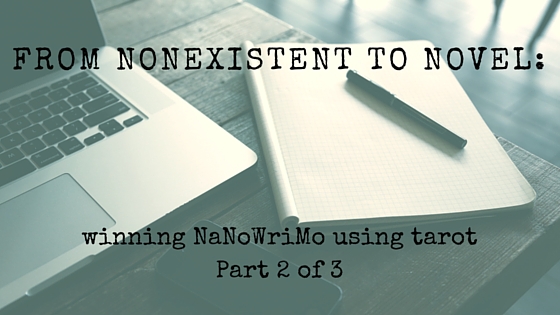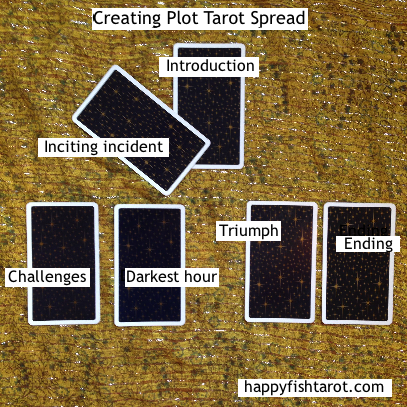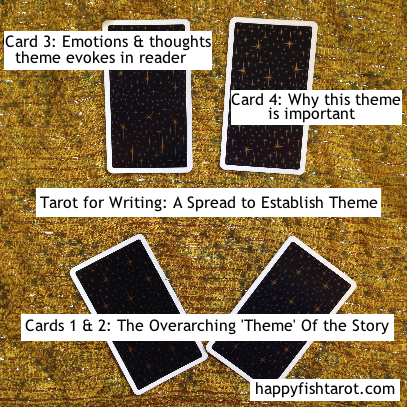
Ever dreamed about writing a novel? This November, move from dreaming to doing! National Novel Writing Month (NaNoWriMo) challenges you to write a 50,000 word novel during the 30 days of November.
In this three part series, I’m showing you how to prepare for NaNoWriMo from scratch. I’m not a published author, and I’m not a real writing teacher. I’m just a chick who has, with the aid of tarot, won NaNoWriMo five times (winning just means finishing, but that’s the best kind of winning). I want to help you do the same thing!
This is part two of the three part series. Find part one here.
Welcome to part two of our epic novel-writing prep series! In part one we talked about building the big, broad picture of your novel. After going through last week’s exercises and considering the input of your tarot deck, your novel should be starting to take shape.
At this point, you know what genre you’ll be writing. You’ve pulled some tarot cards to consider the whos and whats of your story. You’ve spent some time getting to know your characters, and you’ve wrangled together the bones of your plot. Now you’re ready to take those bones and slap on some flesh.
In today’s post, you’ll take your big, broad picture and paint in more of the details. You’ll look at fleshing out your plot, considering your story’s theme, and writing an outline. Then, you’ll come up with a quick and catchy way to describe your story to all the nosy people who will soon be asking about your novel!
It is fun to daydream about characters, settings, and other fanciful novel indulgences. But eventually, you’ve got to take all those notes and cook them into a coherent plot! What actually happens in your story? How does the action start, progress, and wind down? These are the questions you’ll be considering today.
In the previous post, I mentioned that there are countless ways to construct a plot, but they all generally have one thing in common: they require a beginning, middle and end! You’ve now done a three card spread in this vein, so you’ve got at least a baseline idea of how your plot proceeds. Now you can take that baseline and color in the gaps.
Let’s look at a few formats you can use to create plot. There are many other plotting theories you can consider, so don’t feel like you must use a tactic outlined here! The ideas I’m sharing with you are simply a couple of structures that might be useful jumping off points.
This is one of the most common, ancient, tried ‘n true ways to consider plot progression. The most basic way to think of the three act structure is a literal division of your story into beginning (act one), middle (act 2) and end (act 3). Here’s a more detailed view of what that might look like:
Act one: Beginning. In this act, the premise of your story is introduced. We get to know your characters and get a feel for their ordinary (pre-adventure) world. During this act, an inciting incident happens – this is the point where your main character moves from their ordinary world into the main action of the story.
Act two: Middle. This is where the bulk of the story unfolds! Your main character is now in the thick of whatever ordeals you bestow upon them. Challenges and setbacks are actively presented, and the characters struggle to meet their goals. At the end of act two, the darkest hour occurs. The greatest challenges must now be faced before the story finds resolution.
Act three: End. This is where things start to wind down. The main conflicts are resolved, and we see how the world and characters have transformed.
Joseph Campbell was a highly regarded scholar and all around bad ass. He studied world mythology and is most famous for presenting his ideas on the hero’s journey. The hero’s journey shows a basic plot progression that is present in countless stories from various cultures and time periods. Many modern stories align with the hero’s journey (including Star Wars and Harry Potter). Lots of people have given much more detailed and articulate explanations of this concept than I ever could, so I’ll keep it brief!
There are twelve stages to the hero’s journey progression. Each stage marks a progression in the plot as well as the character’s development: ordinary world, call to adventure, refusal of the call, meeting with the mentor, crossing the threshold, tests allies and enemies, new approach, the ordeal, the reward, road back, resurrection, and return with elixir. There’s a more detailed explanation here.
It’s time to get those tarot cards out again! Give them a good shuffle and then lay out twelve cards – one for each facet of the hero’s journey. Take ample notes on any new insights these cards give you into your story’s progression.
As fascinating as the hero’s journey is, it’s a lot to grapple with (especially when you’re trying to iron out your plot relatively quickly in anticipation of NaNoWriMo). The following is my favorite way to consider plot. I’ve plucked a few essential plot elements from various established structures. This format works well for me, and it might be useful for you, too. Have your tarot cards ready and I’ll show you my plot structure in the form of a tarot spread.

Card 1: Introduction, how the story begins.
Card 2: Inciting incident, how the action starts.
Card 3: Challenges, what gives the plot complexity.
Card 4: Darkest hour, where things hit rock bottom.
Card 5: Triumph, how the previous card is transcended.
Card 6: Ending, how the story winds down.
Before you jump into writing an outline, let’s take an intermission to consider theme. The plot is the actual series of events, challenges and happenings that go on throughout your story. The theme is what these things actually mean, teach or suggest. There are a lot of ways to think about theme, but I find it simplest to ask: what is the central message of my story? What message would I want a potential reader to walk away with?
Considering your theme is important because it can serve as an anchor for your writing. When you’re struggling to tie together your plot, focusing on the central message can help the next step become clear. Your theme can be as broad or narrow as you’d like. For example, my novel’s theme is the nuances of balance and self-actualization.
It’s time for another tarot spread! This one will give you inspiration as you contemplate your story’s central theme.

The world of NaNoWriMo is divided into two types of people: planners and pantsers. Planners are those who diligently map out their novels in advance, stockpiling notes and detailed outlines. Pantsers are those who fly by the seat of their pants, preparation be damned. If you’ve made it this far in my posts, you’ve got at least a bit of the planner spirit!
When it comes to writing an outline, I fall in the middle of the planner – pantser spectrum. It can be incredibly useful to have an outline as you start (gulp) actually writing your novel. An outline keeps you on track and ensures the story is going where you intend it to go. But most writers have had that experience of dutifully crafting an outline, only to find out that inspiration took them in new directions during the actual writing phase.
And so, my humble preference is to create a useable, guiding outline that still gives room for flexibility and eleventh hour changes. Here’s how I structure my outlines.
I start with a one sentence declaration of my theme. This goes at the very top of my outline document so that I can keep it in mind as I write. Then, I divide my plot into three acts, as we talked about earlier. From there, I simply write bullet points outlining what happens in each of these three acts. Sometimes I will have ideas for specific bits of dialogue, foreshadowing, or character development I want to include in different segments. If so, those go in the outline.
That’s it! Just a three act division and bullet points. It’s nothing fancy, but it works for me. If you’ve done the plot development tarot spreads above, you should have plenty of ammo to create an outline in whatever format appeals to you.
I attended a local kick-off party the first year I participated in NaNoWriMo. I met a lot of interesting people there, and each one of them asked me the same question. “So, what’s your novel about?” My response was a jumbled mess of “ahs” and “ums” followed by inarticulate ramblings and over-explanations. Yikes!
Of course, it’s natural to have a high level of “winging it” when it comes to NaNoWriMo, and you don’t need to have a succinct, perfect way to describe your novel. That being said, coming up with a one-sentence elevator pitch can be pretty dang fun, and it gives you a snappy way to respond to your inquisitors. I got this idea from Randy Ingermanson’s Snowflake Method, which you can read more about here.
Your sentence will be a pared down way to convey the central theme, challenges and intrigue of your story. It should give just enough information to pique curiosity. If you’re at a loss at how to go about this, think about describing the beginning, middle and end of your plot in broad terms. For example, my elevator pitch might go something like this: “When her father drowns, an unprepared girl attempts to fulfill the metaphysical responsibilities she never knew he had.”
A few years ago, I took a community ed writing class. I proceeded to quickly forget most everything I learned, but one thing the teacher said has always stuck with me. She talked about how when you’re working on a novel, your title can become your totem. While your novel is abstract and unwritten, your title can be a beacon guiding you towards creating something real. This really hit home for me, and I always like to have a title (or at least a working title) for my novel before I begin writing.
Of course, many authors do not have a title until their novel is well underway, or even until after it is completed. But if you feel drawn to the idea of title as totem, I recommend spending some time contemplating your title before NaNoWriMo begins. Having a title nailed down can make help novel seem real, inspiring and exciting!
Deep breath – whoooo boy! You’ve made it through part two of our three part series, and the hardest work is done! We’re through with the nuts and bolts of novel preparation, and next week we’ll focus mainly on mindset. We’ll talk about working with your inner critic, grappling with perfectionism, and creating the time and energy you need to write your novel. I’ll also give you some practical, straightforward ways you can organize your life and focus on write, write, writing in November.
I want to hear from you! Leave a comment and tell me how your preparation is going. What aspects are proving the most challenging so far? What’s going really well? If you tried the spreads and exercises above, how did they go? If you enjoyed this post, I’d be super thrilled if you share it with a writerly friend!
Until next time: keep on writing. Keep on kindling enthusiasm. November is going to be legendary!
Find part 3 of this series here!

Book a private reading with me here.
Subscribe to receive my {free} monthly e-gazette & four {free} guided tarot meditations.

 I'm a tarot reader and mentor.
I'm a tarot reader and mentor. 